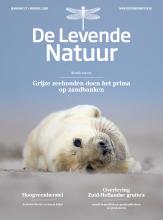De Levende Natuur nummer 5 van 2024 (English summary)
Afbeelding

Eurasian Water Shrew can be detected in four ways
In the Netherlands, live-trapping is a commonly applied technique to study the presence of Eurasian water shrews (Neomys fodiens). However, live-trapping is invasive, labour-intensive, and expensive. Alternative survey techniques such as camera trapping and environmental DNA (eDNA) are more cost-efficient and less invasive, but so far insufficient studied in terms of their detection probabilities. In this study, we compared the following four survey techniques: (1) live-trapping, (2) camera trapping, (3) eDNA sampled from soil, and (4) eDNA sampled from water by estimating their detection probabilities.
We compared these four methods based in a field study consisting of 590 unique measurements sampled at 195 locations throughout the Netherlands and estimated their detection probabilities using a Bayesian occupancy model. Our results show that the detection probabilities of these methods range from 69-73% and do not differ significantly from each other. Overall, sampling in autumn resulted in significantly higher detection probabilities than during spring. Our main result shows that each of these methods approximately equal in their detection probability of a Eurasian water shrew. The highest detection probabilities can be achieved by parallelly implementing two methods. A combination of the two eDNA techniques are most complementary to each other, followed by a combination of water based eDNA and camera trapping. However, generally, in future studies that aim to study the presence of Eurasian water shrews, we recommend applying the survey techniques camera trapping and eDNA (both soil and water based) over live-trapping, since they are less invasive while yielding similar detection probabilities.
Urban blackbird benefits from greenery
The urban population of the Netherlands' most numerous bird, the Blackbird, has been declining since 2007. Here, we try to find out what factors might play a role in the decline of the blackbird in urban areas of the Netherlands. We examined to what extent different urban variables, such as amount of green space or type of buildings, could explain the number of Blackbirds in urban areas. The results showed that all urban variables examined here, except for cooling, have a significant effect on Blackbird numbers. Most variables indirectly indicate the importance of urban green space, as areas with a high green index offer more nesting and foraging opportunities, as well as shelter, and residential areas often contain more green space than, for example, industrial areas. The results of this study suggest that the availability of green space in urban environments is important for the conservation of blackbird populations and that its decline may play a role in the low Blackbird nesting success in recent years, as well as the Blackbird population decline. The exact causal mechanisms of why urban green space positively influence Blackbird populations remain to be studied.
Summer Lady's-tresses gets a second chance
In 1937, the summer lady's-tresses Spiranthes aestivalis disappeared from the Netherlands due to clearing, drainage and eutrophication. But although the old growth sites in Southeast Brabant and Central Limburg have been greatly improved in recent decades, the summer lady's-tresses has not returned. As of 2015, the Netherlands Society for European Orchids (WEO) has therefore been investigating whether reintroduction of this iconic species for moist heathland/blue grassland could be possible.
Thirteen original growth sites were examined for suitability (vegetation, soil fungi). One area stood out, where nine of the ten characteristic species that accompany the summer lady's-tresses are present again, hydrological conditions have been restored and slightly alkaline seepage has returned.
In 2021, with permission from the French authorities, seeds were collected from the nearest growing site (Lessay in Normandy, France) and subsequently sown in vitro by the Society for Orchid propagation (VOV). About 900 plantlets were planted at 12 different locations in the area in question during the period spring 2023 - spring 2024. In the summer of 2023, 28 plants had already flowered and 12 plants had set seed.
Evidence of sustainable reintroduction is now awaited: the discovery of spontaneous seedlings in the field.

